
Red Crescent - The Sultan of Mauretania's bid for Hispania
- Thread starter TinMann
- Start date
-
We have updated our Community Code of Conduct. Please read through the new rules for the forum that are an integral part of Paradox Interactive’s User Agreement.
You are using an out of date browser. It may not display this or other websites correctly.
You should upgrade or use an alternative browser.
You should upgrade or use an alternative browser.
I am sorry about that... |
Chapter 4: The Golden Age of Mauretania August 19, 997: Dark tidings | |

It would become tradition that the final act of the Shia Caliph would be to die promptly after starting a holy war against a significant enemy. This was exactly how Tabat II came to power. His father, Prince Keraja, unfortunately passed away from great pox in November of 991. As the next in line, Tabat II was only twelve years of age when he assumed the dual role of Sultan of Greater Mauretania and Shia Caliph. The Sultanate of Greater Mauretania, as it was now being called, by this time was a very significant realm. Almost 3,000 miles from east to west, stretching from France in the north to Mali in the south, it was a land that needed a strong and energetic leader to hold together. Unfortunately this heavy mantle fell on Tabat II before he was properly prepared. Plots and factions formed at a terrifying pace while his army was heavily engaged in Arabia. This was perhaps the Idrisid dynasty’s most desperate hour. It turns out the single greatest threat was within Tabat’s own family. Emir Muhammad, his cousin who was assured he would assume the Sultanate of Egypt, by then was furious over the unfulfilled promise. By this time Muhammad had decided he wanted not only Egypt but in fact all of Greater Mauretania itself. A desperate chain of events followed. In the end Muhammad was captured just days before an ultimatum was made for Tabat II to relinquish his titles. The traitor was executed in prison that same day, diffusing the plot that would have torn Mauretania apart from the inside. This intrigue was only the first of many that formed in the chaotic early years of Tabat II’s reign. Many of these were resolved only through bribes, assassinations, imprisonments and blackmail – and often at the last possible hour. Tabat’s ascension to power was indeed a close run thing. The political climate settled somewhat when a 13,000-man Catholic revolt broke out in Santiago in early 998. Tabat was quite relieved when the Arabians surrendered Al’Aqabah on April 8th, which freed the bulk of Tabat’s army to deal with internal matters. In Hispania it seemed as soon as one Catholic revolt was extinguished another flared up. While this was distressing to the young Caliph, it did help to minimize the infighting and backstabbing of his vassals that pervaded his teenage years. While he was kept out of many of the darker decisions made by his council, he was intelligent enough to recognize what was going on around him. This environment provided him a political education that would later serve him well. Despite all of their efforts to hold the realm together, however, a major independence movement appeared unstoppable in late 998. Out of desperation, Tabat’s counsel and regent forced Tabat to relinquish Mali, where many of the plotters were based. Letting them go forestalled open rebellion across the entire length and breadth of the country, and also relieved a great deal of administrative stain. The crisis passed, but in the end Tabat was furious with the chain of events. He was now the first Mauretanian Sultan to surrender territory in almost 150 years. | 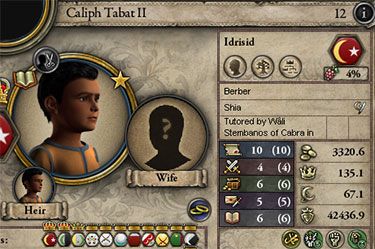
Caliph Tabat II in 997.
|
August 3, 1002: The road to Mecca | |
| Around the turn of the millennium chaos erupted outside Mauretania’s borders. Aquitaine, which had split off of West Francia a generation ago, was once again involved with a massive war their former countrymen. Around that time a decadence revolt against the Arabian Caliph succeeded, placing the 40-year old Caliph Aram ‘The Conqueror’ in command of the Empire to the east. Shortly thereafter the Great Seljuk arrived and began laying waste to the Turkmen and Persian Sultanates. Despite all of these external events a growing calm had settled across Mauretania as Tabat II came of age. He reached his majority on August 3 of 1002, immediately married and undertook his Hajj, as was tradition. Upon his return he made it clear to his advisors that the shame of Mali would need to be cleansed from his legacy. He would not retake the lands to the south, however, which he saw as impoverished and distant. Rather, he would continue to push eastward to fulfill the dreams of his forebears: he would take Mecca for himself. His advisors were horrified at what their leader was going to attempt so early in his reign. They desperately tried to talk him out of it, arguing that the realm was already too large to manage – but to no avail. The best military minds in the realm gathered in Granada for the months of planning that followed. In January of 1005 Tabat felt strong enough to strike and ordered his retinue and mercenaries to the border. He declared a holy war for the Emirate of Medina on May 24 of 1005 against Caliph Aram ‘The Conqueror’, who governed over a fractured Arabian Empire Taking a page from his grandfather’s book, The Caliph remained with his cavalry in reserve around Al’Akbar while his mercenaries and skirmishers advanced into Hijaz. While the heavy troops were besieging Hijaz, the Caliph’s army began sweeping neighboring provinces looking for small groups of enemies to ambush. This caught the attention of an enemy army slightly larger than their own which was met at the Battle of Eliat. Outnumbered, Caliph Tabat’s army still won the day by a wide margin, although Tabat was wounded in the process. He returned to Grenada for the remainder of the conflict to recover. Even though Caliph Aram had brought in neighboring Sunni leaders to help, the Mauretanians were still too powerful. A number of battles and sieges culminated in Caliph Aram’s surrender on February 14, 1007. What had been the distant fantasy of his forebears was now a reality: the holy sites of Mecca and Medina were part of Mauretania – and under the control of Shia. Shock waves resonated across the Sunni world. Meanwhile the overjoyed Shia population celebrated like had never before. | 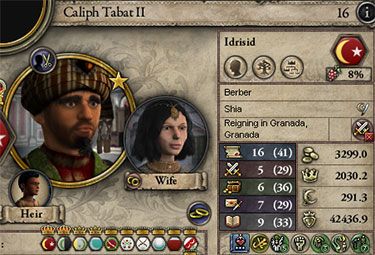
|
February 14, 1007: Ironside | |
| During his reign Tabat II launched a number of other holy wars which he fought with retinues and mercenaries alone, leaving his vassals virtually at peace. While localized religious and national rebellions still took place from time to time, they were each handled in turn before any significant damage could be done. The resulting internal peace and stability resulted in a flowering of art, culture and education across the realm. What future historians would one day call the ‘Mauretanian Golden Age’ had begun. This newfound stability and prosperity was in part due in part to Tabat’s ruthless policy of arresting dissenters whenever given just cause. The sheer number of arrests made during his tenure earned him the nickname of ‘Ironside’, which he never really liked. Those so-called ‘private’ wars that Tabat led included the claiming of the independent Emirates of Bagdad in 1016, Tunis in 1018, and the sheikdom of Tabuk in 1020, expanding the Mauretanian footprint deep into Arabian territory. The internal chaos that had engulfed the Arabian Empire for generations continued, a point that was not lost on Tabat and his generals. Arabia and her former vassals eventually realized that Mauretania’s attacks were part of a larger campaign to annex them all and make Shia the dominant religious branch of the faith. As a result they offered up more urgent resistance when a holy war for the Emirate of Oultrejourdain was called in February of 1021 against the independent Emir Turhan Selaid ‘The Wise’. Despite the coalition of Selaid, Caliph Aram and two other independent Emirs, the decisive battles of Maan and Madaba wiped out the allied armies to a man. The Emirate was surrendered to Tabat on April 29, 1022. October 24, 1022 a holy war for Hayya (in Abyssinia) was called, which was completed on December 30th of that year. A second war for Atbara, the last province of de jure Nubia, was declared in August of 1025 and completed by mid-October. Now unified under Mauretanian rule, all the lands of Nubia were given to Tabat’s son and heir, Idir, who was named their Sultan. Effectively this granted him independence, though he remained Ironside’s heir. Around that time a few members of the Caliph’s family disappeared under mysterious circumstances. In 1028 Sultan Ghalib Hashimid of Arabia, whose lands made up 75% of the Arabian Empire at the time, became independent of the Sunni Caliph. This was interpreted in Mauretania as the death knell of the old Arabian Empire. While the title would live on, the status as a major power had been lost by the Arabian Caliph, perhaps never to return. It was then that Tabat and his advisors resolved to secure the Arabian Empire title for themselves, ostensibly to stabilize the region and continue to spread the Shia faith. Practically speaking, Tabat wanted it mainly for another reason: to keep anyone else from holding it again other than his descendants. To that end, Tabat declared a holy war for those portions of the Emirate of Arabia that the Hashimid Sultan controlled. The battles were one-sided and the war was completed by September 17th of 1028. In April of 1031 he then declared war on the Arabian Empire for control of the remaining territory in the Emirate of Oultrejourdain. Since the Caliph was involved in four other wars at the time, no armies were mustered to meet them, and Arabia surrendered on March 18th of 1033. Later in 1038 Tabat decided to liberate Jerusalem from the independent Beylerbey Balaban Selaid, which was accomplished on October 5th after a short siege. Tadjura, in Ethiopia, was claimed in 1042. Back home, by 1036 all of the emirates of Andalusia and the islands of Mallorca had become formally incorporated into the Sultanate of Mauretania. This contributed to the sense that the people of Mauretania were indeed living in a Golden Age. Following an observation of Ramadan, Ironside declared war on Sultan Nasr Aramid of Arabia for the Emirate of Nefoud in early 1042 (the central area of the Arabian Peninsula). This proved more of a challenge than expected as the Sultan was able to muster a significant force to meet them. As with Tabat ‘The Great’, Tabat II ‘Ironside’ died shortly after declaring war – rocking the realm once again down to its foundations. Caliph Tabat II ‘Ironside’ surrendered land early in his reign but made up for those losses later in life. Although the territory he conquered was impressive, it was achieved against relatively little resistance. The hard work had been accomplished by his forebears when Arabia was in its heyday. The successes of his grandfather caused the Arabian Empire to implode, and Tabat II exploited the power vacuum left in its wake. Still, it always takes personal and political courage to assert oneself and one’s religion in the Middle East. Furthermore he managed to extend his realm’s footprint while providing enough domestic stability to allow the arts and sciences to flourish. Those contributions may indeed be his most enduring legacy. |
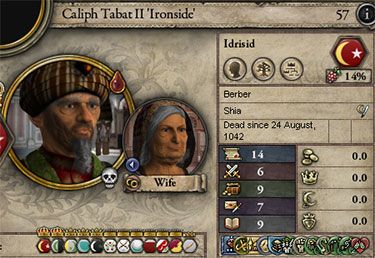
|
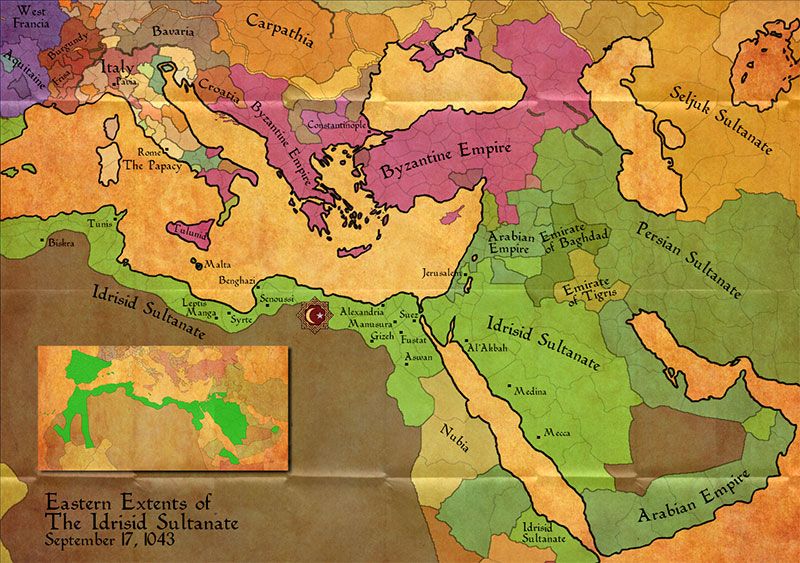
Last edited:
It would become tradition that the final act of the Shia Caliph would be to die promptly after starting a holy war against a significant enemy.
Ain't that the truth?
Sotty to hear that you had to let Mali go, is it a Shia sultanate at least?
It was! I put a Mande Shia Sultan on the throne but he has lost about half of his lands to rebels (I've been too busy to help). Frankly that's OK with me since those folks will be killing each other for centuries to come, leaving me alone. If I need a holy war I will send some folks down there to shake things up, but otherwise I've moved on.
Thanks!
Awesome AAR. Any plans to avenge the defeat at Tours and install a sultan in Aquitaine?
Awesome AAR. Any plans to avenge the defeat at Tours and install a sultan in Aquitaine?
That is a fantastic idea. Now that I've almost achieved everything I set out to do, I was looking for an up note to end on. Thanks!
| August 24, 1042: Idir 'The Unready’ | |

Tabat II’s son Idir ‘The Unready’ assumed the Caliphate title in August of 1042. He had earned his unfortunate nickname after failing to protect his Sultanate from Miaphysite rebels early in his Nubian tenure. During that war his father was able to step in and rescue his Sultanate, but not his reputation. That reputation, combined with a lack of diplomatic skill, made him extremely unpopular with his many new vassals. Instantly the realm that had been internally calm for so long came alive with political drama. As a result the start of the new Caliph’s reign was marked with a tidal wave of arrests, assassinations and bribery in an attempt to secure his birthright. Having the army heavily engaged in Arabia certainly didn’t help Idir’s domestic situation very much. With this in mind The Caliph forced a military confrontation at the First Battle of Hail in Arabia that year. This turned out to be a decisive win for the Mauretanians, as well as the Second Battle of Hail in 1043 that was to follow. Idir’s enemy, Sultan Nasr Aramid of Arabia, then fell victim to a decadence revolt. Aramid surrendered the Emirate of Nefoud shortly thereafter on September 17th of that year. Severely weakened by conflict and the loss of Nefoud, Aramid lost his decadence war in short order. In the uneasy calm that followed Caliph Idir declared himself the rightful Sultan of Arabia, which became his third Sultanate title. This shattered the Arabian territory outside of Greater Mauretania into a number of independent lands that quickly swore fealty to the current Arabian Emperor, Caliph Abu-Bakr Abbasid. This development did not concern Idir greatly, however, since the Empire was one in name only. By that time it had been reduced to being merely regional buffer between his realm and the Byzantines to the north and the Saffarid Sultanate to the east. Idir’s claiming of the Arabian Sultanate made it clear to all observers that he was not planning to stop his push into the region anytime soon. The end of the Arabian war was marked with yet another Catholic revolt. Ironically this pleased Idir since it helped to calm some of the internal political strife he was saddled with. Hispania had become more than 60% Shia by that time. As such there was a constant stream of catholic revolts among those people who desperately wanted to hold onto their old ways. In part because of these revolts, three years of internal calm followed which allowed the people of Mauretania to continue enjoying their Golden Age – for the time being at least. Externally, Idir aggressively pursued a series of holy wars on his neighbors. In 1046 ‘The Unready’ claimed most of the land in the independent Emirates of Bagdad and Tigris, cutting what remained of the Arabian Empire in half and forming a border with the Saffarid Sultanate. In 1051 Idir declared war for Damascus on February 13. By June of that year he had completed the conquest, which incorporated the last Shia holy site into his realm. In 1052 he annexed the portion of Gondar in Abbysina that was under the control of Sultan Bahir II of the Ibramimid dynasty. That same year another holy war relieved the independent Sheikh Abdul of Kathiri of his lands in the south of the Arabian Peninsula. After a brief period of peace he once again went to war for the Sheikdoms of Sanaa, Taizz, and Aden from Emir Sadiq of the Cheren Emirate in 1055, who was rebelling against the Arabian Empire at the time. | 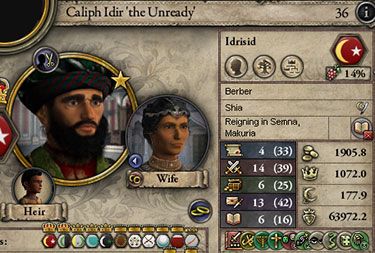
|
As the Caliph grew older he became complacent with his string of political and military victories. What should have been a routine assassination of a political enemy turned ugly, as word of the (multiple) attempts went public. Now, in his later years, he was faced with another scramble to remain in power as powerful factions lined up to depose him. Those who stood against him included almost every male member of his family, which sparked widespread arrests and subsequent executions of potential Idrisid claimants. Unfortunately his efforts were not enough to withstand the flood. For the first time the massive realm of Greater Mauretania exploded into civil war in May of 1060. Ostensibly the rebels wanted to lower crown authority, but in reality they wanted Idir dead. They got their wish when he succumbed to battle wounds in March of 1063. His body was captured and done away with by the very rebels he was trying to destroy. The transition of power to his son Aggur did not end the conflict, unfortunately, which would rage for another six years and push the realm to the very brink. Caliph Idir 'The Unready' was perhaps the least illustrious member of his dynasty. Although he did expand the realm further into Arabia, later in life he allowed the realm to disintegrate nearly to the point of collapse. He was a leader who was missed by few, and one who certainly lived up to his epithet. |
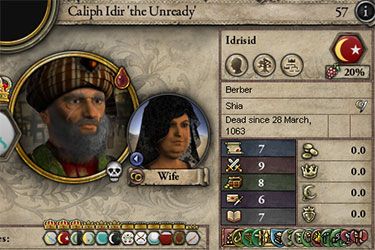
|
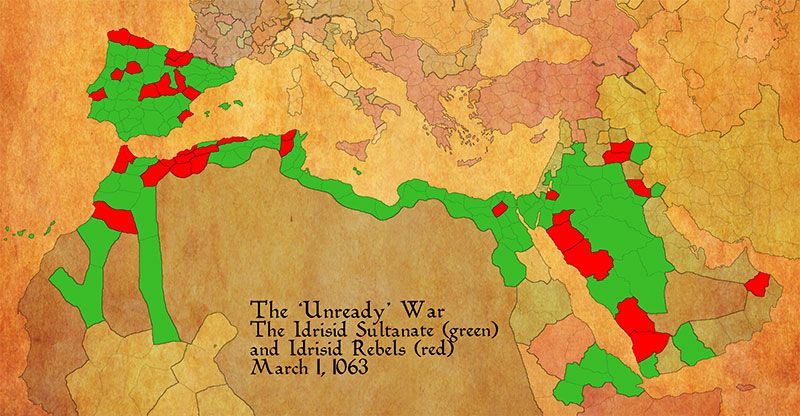
|
Last edited:
| March 28, 1063: Fratricide and Rebirth | |

Prince Aggur became Caliph Aggur in March of 1063 in the middle of the civil war instigated by the widespread hatred of his father Idir ‘The Unready’. Although Aggur tried to reason with the rebels and offered them a white peace, they were uninterested. The war would drag on for years to come killing untold thousands in the process. Aggur had no choice but continue the fight as repealing all the laws passed since Adil I would have been unthinkable. Aggur’s basic strategy was to secure Arabia and Egypt with the bulk of his troops before marching westward. This was no easy task with the rebel holdings scattered about as they were. Matters were made worse when the Arabian Empire declared war on one of his rebels, Sheikh Akulta of Wadi Musa, to retake Oultrejourdain in a blatant land grab during Mauretania’s hour of crisis. This resulted in swirling battles all across the length and width of the Arabian Peninsula with armies marching to and fro multiple times. Finally all of the rebels in the east were neutralized after six additional years of bloody, unceasing combat. Aggur then led a force of mercenaries and skirmishers west across Africa to liberate cities on the long march to Granada. His cavalry stayed behind in order to fend off the Arabian Empire’s forces, which were still trying to snatch territory away while the Caliph was otherwise occupied. During those early years the situation in Hispania was much more desperate. An army of mercenaries were used to fend off attacks on the Caliph’s holdings around Grenada, but there was no stopping the rebels in the north and west of the Iberian Peninsula. Ultimately only the steady stream of Catholic Revolutionaries provided any resistance as they slowly overran the hinterlands of Hispania. Aggur’s plan worked, and his heroic westward march across Africa seemed unstoppable. Finally in June of 1069 a white peace was offered by the rebels which the Caliph heartily accepted. A palpable spirit of reconciliation was in the air as some semblance of order returned to the land. After the dead were honored and walls rebuilt, there was a genuine feeling that the new Caliph’s magnanimity would set all to right, and loyalty to the Idrisid dynasty was at an all-time high. The Arabian attempts to grab land during the civil war had failed. By 1070 Caliph Aggur felt secure enough to launch a retaliatory strike for Ascalon on the Arabian Caliph. The Arabians were completely overwhelmed and surrendered it on August 25th of that year. By June of 1072 it was clear that his realm was beginning to prosper once again. It seemed that the Mauretanian Golden Age would indeed continue after its decade-long hiatus. To mark this fact, Caliph Aggur decided to complete the work of his forebears and finally proclaim Greater Mauretania to be an Empire. He decided to do so at the expense of the Arabians, by usurping the mantle of the Arabian Empire, which was within his rights due to his current holdings. The former Emperor, Caliph Abu-Bakr Abbasid, became an Emir but retained the religious title of Sunni Caliph. When Aggur unveiled his proclamation to the world he chose to rename the Empire to better represent the majority of the noble class who governed it. The Arabian Empire had become the Amazigh Empire. Following this revelation the Caliph granted Sheikh Micipsa of Markuria (in Nubia) independence, in an effort to reduce the administrative strain on his massive realm. Other Caliphs after him would do the same in order to keep the heart of the Empire at a manageable size. Later in 1072 war was declared for Bagdad on its independent Emir. The powerful Saffarid Sultanate to the east stepped to help defend those lands, culminating in the massive Battle of Baghdad. The fight was won decisively by Caliph Aggur and the territory was quickly surrendered. At the end of the year the Sunni Caliph, Emir Abu-Bakr Abbasid, decided to declare war for his claim on the Empire title. He was swiftly defeated as no one joined in to help. In retribution, the Sheikdom of Bayda was taken from him in 1079. Over the coming years Caliph Abbasid would lose what few titles he had left and become a landless noble within the Empire. At that point the Sunni Caliphate title was vacated as well. Although the people to the east still followed the Sunni path for years to come, they would do so without a religious leader. Loved by his subjects, at 52 years of age Caliph Aggur died leading troops against a Catholic uprising in 1081. He was given a martyr’s funeral in Grenada that was attended by throngs of nobles and commoners alike. Caliph Aggur was able to bring peace to a land that was tearing itself apart before going on to bring great honor and distinction to his dynasty. His achievements speak for themselves. | 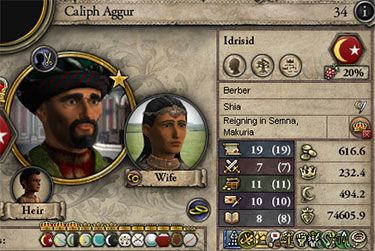
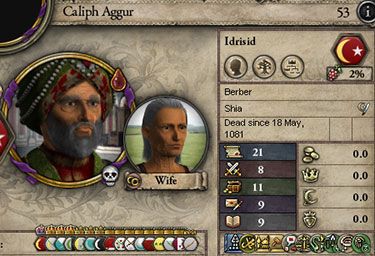
|
Last edited:
I've recently read whole AAR and I must admit that I love it. This formatting, those beautiful maps, and the story itself, and the way you describe it... I think I know what I would vote for the best AAR next time.
Talking about what you should do now, here is my piece of advice:
1. Conquer remaining parts of Arabian Empire.
2. Grant independence to vassals outside de jure Arabia and Hispania.
3. Set a Shia Sultan in Aquitaine.
4. Create the Hispania title, just to cause more problems and to make the game more interesting and more challenging.
5. Fight with other independent Sunni rulers (like Saffarids, if they still have Persia) and replace them with Shia rulers.
6. Try to deal with your decadence without blobbing.
7. It'd be nice if you do some kind of flashback of previous Mauretanian rulers at some point, maybe with a family tree?
And remember to enjoy the game
Talking about what you should do now, here is my piece of advice:
1. Conquer remaining parts of Arabian Empire.
2. Grant independence to vassals outside de jure Arabia and Hispania.
3. Set a Shia Sultan in Aquitaine.
4. Create the Hispania title, just to cause more problems and to make the game more interesting and more challenging.
5. Fight with other independent Sunni rulers (like Saffarids, if they still have Persia) and replace them with Shia rulers.
6. Try to deal with your decadence without blobbing.
7. It'd be nice if you do some kind of flashback of previous Mauretanian rulers at some point, maybe with a family tree?
And remember to enjoy the game
I've recently read whole AAR and I must admit that I love it. This formatting, those beautiful maps, and the story itself, and the way you describe it... I think I know what I would vote for the best AAR next time.
Talking about what you should do now, here is my piece of advice:
1. Conquer remaining parts of Arabian Empire.
2. Grant independence to vassals outside de jure Arabia and Hispania.
3. Set a Shia Sultan in Aquitaine.
4. Create the Hispania title, just to cause more problems and to make the game more interesting and more challenging.
5. Fight with other independent Sunni rulers (like Saffarids, if they still have Persia) and replace them with Shia rulers.
6. Try to deal with your decadence without blobbing.
7. It'd be nice if you do some kind of flashback of previous Mauretanian rulers at some point, maybe with a family tree?
And remember to enjoy the game
Thank you so much!
I’ve played one ruler ahead of what I've written, and we definitely think a lot alike. As of this afternoon I have completed items 1-3. I am planning to wrap this thing up shortly since I’ve hit the points I was hoping to, and would like to start another once RoI comes out. In any case ideas and feedback are always appreciated.
I've enjoyed this greatly as well.
It's a bummer that the current decadence system makes it impossible to be generous to your relatives, especially as your realm increases in size. While the Ottomans may have ruthlessly trimmed the family tree, Arabian culture (then as now) places a huge emphasis on family and extended clan ties, so landing your kin shouldn't be so suicidal. Thankfully, the new ROI decadence system seems to fix this.
I like that you're granting independence to various realms under Shi'a rulers, since that's something I often do to avoid blobbing. Just mark them as favorites and intervene as necessary. Much like you did in Mali, I have a soft spot for establishing rulers of the local ethnicity.
While I understand the usurpation of the Arabian empire, part of me wants to see greater Mauritania/Hispaniola stand alone, in a tight, powerful empire, rather than the great sprawl. While granting independence to a whole empire is silly, maybe a particularly beloved leader could destroy the title and grant independence to Sultans underneath (just before he dies, naturally).
I like what Yoroii said about trying to place Shi'a rulers in other lands outside your control; one way to do that is to get claimants, convert them to Shi'a, and press claims, at least for the sake of role playing if nothing else. The party of Ali must put an end to the decadent usurpers who deny the supremacy of the family of the Prophet!
It's a bummer that the current decadence system makes it impossible to be generous to your relatives, especially as your realm increases in size. While the Ottomans may have ruthlessly trimmed the family tree, Arabian culture (then as now) places a huge emphasis on family and extended clan ties, so landing your kin shouldn't be so suicidal. Thankfully, the new ROI decadence system seems to fix this.
I like that you're granting independence to various realms under Shi'a rulers, since that's something I often do to avoid blobbing. Just mark them as favorites and intervene as necessary. Much like you did in Mali, I have a soft spot for establishing rulers of the local ethnicity.
While I understand the usurpation of the Arabian empire, part of me wants to see greater Mauritania/Hispaniola stand alone, in a tight, powerful empire, rather than the great sprawl. While granting independence to a whole empire is silly, maybe a particularly beloved leader could destroy the title and grant independence to Sultans underneath (just before he dies, naturally).
I like what Yoroii said about trying to place Shi'a rulers in other lands outside your control; one way to do that is to get claimants, convert them to Shi'a, and press claims, at least for the sake of role playing if nothing else. The party of Ali must put an end to the decadent usurpers who deny the supremacy of the family of the Prophet!
| May 18, 1081: Reign of the Apostle | |
| Aggur’s son Aran began his reign in 1081 at age 23. Like his father, Aran was also accomplished in the essential the art of diplomacy, which ultimately helped facilitate his peaceful transition to power. The only hiccup took place while Aran was on his Hajj when his regent, Shiekh Aras of Saraqusta, chose to lower crown authority in his absence. Aran’s response was calm and metered but the betrayal was not forgotten. Later in his career Aran was able to restore those laws without incident. By 1084 Aran felt secure enough at home to continue the expansion of the realm as his forefathers had done. He declared war on the Sunni Caliphate and in 1085 took control of their holdings in Nubia. Next he claimed Sinar in Mesopotamia from Satrap Darab Kartid the following year. He continued consolidating Mesopotamian territory by declaring war on Emir Is’mail II for all of Basra in 1086 as well. When that conquest was completed in 1087 the Caliph created the Sultanate of Mesopotamia and bestowed it upon his cousin Rafan Idrisid before granting him independence. Rafan, who was extraordinarily pleased with these events, promised the Caliph that the two nations would be allied until the end of time. The Caliph then turned to the task of absorbing what remained of the independent states in Arabia and Abyssinia, which culminated in the annexation of Al Hasa and Dhu Zabi in 1088, Tiberius in 1089, as well as Sur, Safed, and Beirut in 1090. The remainder of Oman was claimed in 1092, and the Emirate of Harer in Abyssinia followed in 1094. Around that time Aran created the Sultanate of Abyssinia and bestowed it upon his loyal general Iher Adergazuzid, transferred all vassals in Abyssinia to him and granted him independence. |
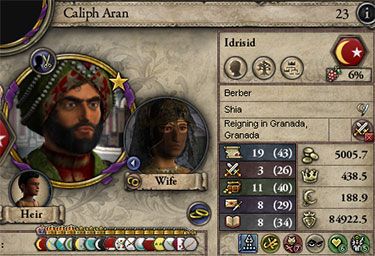
|
Then came the first of many momentous events in Aran’s long reign. On April 12 of 1094 the Pope called a Crusade for Jerusalem. Caliph Aran was genuinely surprised by the attack but nonetheless responded immediately. For the first time in generations all of the levies of the realm were called forth to do battle. Before it was over most of the landholders of Western Europe would come to fight in the holy land, which included the Kings of England, Ireland, Brittany, and Aquitaine, as well as twenty-one Dukes. 
The Caliph’s strategy was simple: place his armies inland, allow the Christians to land and then mercilessly push them back to the sea. For five years the Crusaders came in their armies, sometimes of 5- and 10-thousand men, and each was met in turn. During those years countless men fell on both sides, but more Europeans than Amazighs paid the ultimate sacrifice. By November of 1098 the Crusade was called off without having completed the siege of a single holding. Following this watershed victory a month of celebration was called throughout the Muslim world. The Crusades taught Aran two important lessons. First, that his Catholic neighbors (whom his nation had not attacked in generations) were not interested in a peaceful coexistence. Second, he learned that they could be beaten – even when fighting large numbers of them at once. This inspired him to one day reattempt what many thought to be impossible – the Muslim invasion of Aquitaine. Dreams of what would later be called the ‘Second Invasion’ were put off until after Arabia was consolidated, which would take another four years of constant conflict. At the end of that time Aggur became popularly known as ‘the Apostle’ for the large number of holy wars he had fought and won. With Arabia secure, galleys from across the realm were ordered to Alexandria where his eastern forces gathered. For the first time in a century his standing army of retinue and mercenaries was returning home. While they were en route to Hispania, High Priest Butvydas of the reformed Romuvan faith, declared a Great Holy War for Germany. Aran could hardly believe his luck. He and his generals were convinced that Christendom could not possibly resist to great invasions at the same time. Plans for the start of the Amizagh attack were moved forward. | |
August 17, 1102: Aquitaine and beyond | |
| In August of 1102 Caliph Aran officially proclaimed the Second Invasion of Aquitaine. His armies struck northwards in a quest for new territory, but also to avenge the shame and humiliation of The Battle of the Palace of Martyrs (The Battle of Tours). The Caliph himself led the left flank of an 8,000-man cavalry force that included his heavy horsemen. They and a separate 15,000-man army of mercenaries and skirmishers under Sheikh Musa attacked around the southeastern tip of the Pyrenees. Meanwhile Sheikh Abakada of Tiberias took command of a separate force of 6,000 light cavalry which blocked the passes into Hispania from the northwest end of the mountain range. A fourth unit of 19,000 personal levies and additional mercenaries under Sheikh Uzza of Kairwan would remain in reserve. His vassals were ordered to keep their levies at home until called for. Musa’s army moved to Carcassonne where it laid siege to the county capital. Meanwhile Caliph Aran’s force raided Toulouse and caught sight of an 18,000-man Aquitanian army moving towards them. The Caliph’s men withdrew to Rosello where reinforcements were being rallied in anticipation of an enemy move on Carcassonne. Meanwhile the light cavalry in the north did not encounter any enemies and started moving south to support the other units. The large enemy army inexplicably retreated away from the area and left the attackers alone for months. As a result Carcassonne was starved into surrender in January of 1103. By February Musa’s army had stormed the other holdings nearby which eventually forced the hand of the King of Aquitaine. Their army reluctantly moved to Carcassonne and met Musa’s smaller force on February 22nd as the Caliph’s cavalry raced over the hills from Rosello to assist. | |
The Battle of Alet, as it would later be called, was a slaughter. Ten thousand Aquitanians fell with Aran losing less than a thousand men. Aran led the pursuit to the mountainous province of Foix where the enemy army was completely destroyed. Aran’s armies then simultaneously laid siege to Toulouse, Narbonne and Foix, while he kept his heavy cavalry near Carcassonne in reserve. Without taking to the field again, Aquitane eventually surrendered on February 25 of 1104 once the south of the country was firmly in Aran’s hands. The Caliph and his generals could hardly believe what they had accomplished in less than two years. Finally, after so long, the shame of Tours was wiped clean and the faith had been carried north of the Pyrenees. Aran and his armies were too busy to celebrate for long. Several tense weeks followed as the Christian nobles in Aquitaine were rooted out and replaced by loyal Shias. This process was completed by April of 1104 without incident. Aran received word that during this same timeframe four Christian Crusading orders were formed in rapid succession. (A fifth, the Knights Templar, would organize a few years later.) In May the situation in Aquitaine was deemed stable enough for most of the army to be transported back to Arabia. There the Byzantines and Saffarids were at war with Aran’s cousin Rafan in Mesopotamia, who was in danger of losing both conflicts. Once his armies had returned to the East Aran was able to turn the tide in both wars. In 1107 he called a successful retaliatory holy war for Tripoli on the Byzantine Empire. Around that time the Shia lords of Aquitaine became united under Emir Kawsen of the Sidon Emirate and granted independence. Also in 1107 the Romuvan Great Holy War for Germany was successfully completed. King Povilas of Lithuania now held all of Central Germany, in addition to about half of the de jure lands of Russia. Aran found these events quite amusing. Intermittent regional and religious revolts kept Aran fairly occupied in the years that followed. | 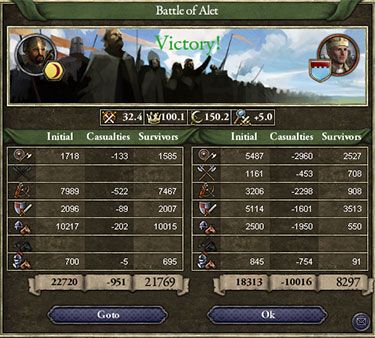
|
August 1, 1112: Final conquests | |
| At home, Caliph Aran was regarded as a hero like no other before him. With his domestic affairs well in order Aran decided to continue his conquests in 1112 by retaking some land in Mali, and then later the Island of Sardinia from Italy. Also in 1112 Emir Kawsen usurped the Sultan of Aquitaine title from the former King of Aquitaine. At the time his new nation was already able to field the tenth strongest army in the world. Aran took great pride in having created this new land to the north. Around that time the Monophysite King of Nubia had adsorbed most of the independent Shia states in Abyssinia. In response to this Aran declared war on them for the Emirate of Hayaa. Following their surrender, Aran usurped the Kingdom of Nubia title, which caused Nubia to fragment. The land and title was given to Igmi, the Sheikh of Nubia proper. Later wars on the independent realms in the region pushed the Amazigh Empire deeper into Abyssinia with the claiming of Sennar, and parts of Axum and Gondar, which were all given to Aran’s loyal subject Sheikh Khalid. In 1119 Aran took Corsica and then embarked on what was perhaps his most bold conquest yet: a holy war for Rome itself. Weakened as they were from constant warfare, the Christians of Europe were unable to form a meaningful defense of the Holy See. Pope Sylvester surrendered the city on November 14 of 1119, but was allowed to remain in Rome as a landless resident of the Amazigh Empire. | |
In 1123 and 1124 the last remaining Monophysite rulers were expelled from Abyssinia. Emir Khalid was given the title of Sultan of Abyssinia, and he and the Sultan of Nubia were granted independence. Caliph Aran, the greatest of all Mauretanian Sultans and Shia Caliphs, finally passed away in peace shortly after completing the conquest of Nice in 1128. He was 70 years old. In his 47-year reign Caliph Aran unified Arabia, Nubia, and Abyssinia; withstood the Crusade for Jerusalem; conquered Aquitaine; created and protected a number of significant Muslim neighboring realms; conquered the Papacy in addition to a significant portion of Central and Northwest Italy. It is hard to understate the magnitude of his accomplishments. In all likelihood his leadership had secured a long and bright future for his people, who would undoubtedly continue their push into the heart of Europe itself. Thanks to his achievements, and those of his forebears, the Mauretanian Golden Age would continue for generations. | 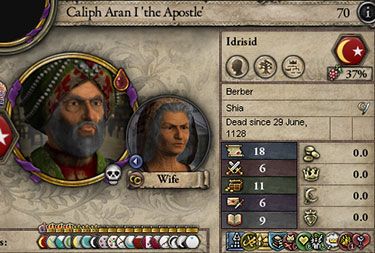
|
|
Last edited:
Epilogue |
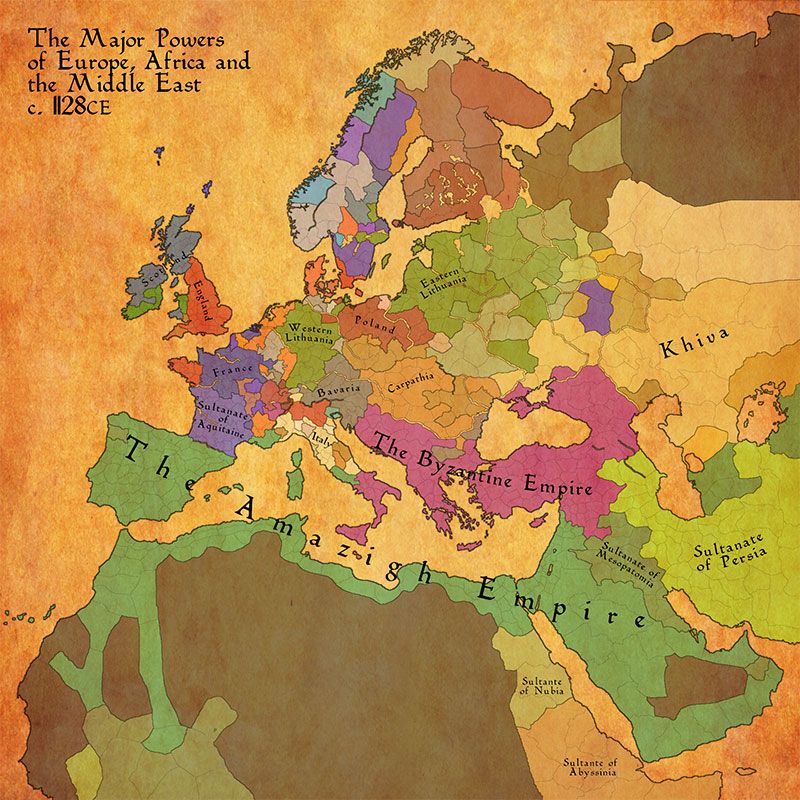
|
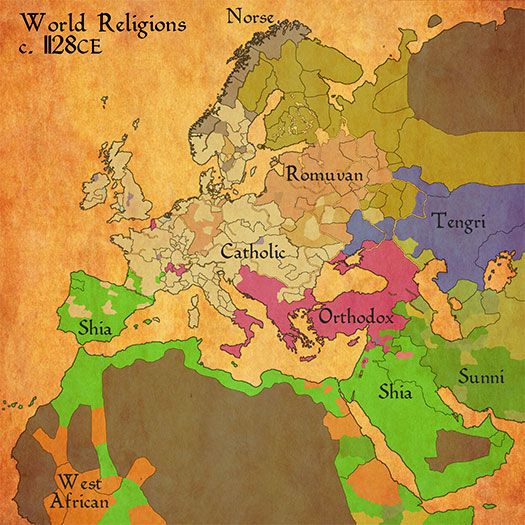
| 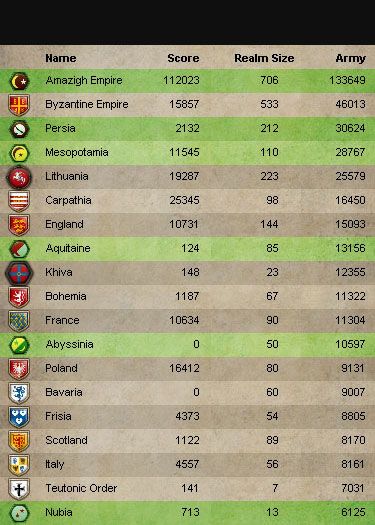
|
Distribution of world religions in 1128. | A chart of major powers in 1128 ranked by army size. Those nations with Muslim leaders have been highlighted in green. |

| The Idrisid Dynasty’s explosion onto the world scene was dramatic and unexpected. Their ancestral homeland of Mauretania started as a medium-sized power in 867 which quickly was able to overrun its neighbors. Caliph Yahya I ‘the Bold’ and his son Adil were able to annex North Africa all the way to Tunis in addition to southern Hispania during their reigns, setting the stage for even greater conquests. This expansion was facilitated by the majority of Mauretanians following the Shiite path, a distinction that allowed them to very effectively make use of holy wars in their expansion. The ascension of the Sultan to religious leader of the Shia only expanded the strength and standing of the realm. The next phase of Mauretania's history was a mixed one as the influential Caliph Keraja I defeated both the Umayyads in Andalusia and the French in Barcelona to claim the lion’s share of Hispania. He did this only reluctantly, though, as the Sunnis to the north refused to work together with him. Despite a great deal of personal anguish over the brutality that involved, the realm nonetheless benefited greatly from his efforts. Later, the Second Caliph Adil nearly completed the conquest of Hispania and pushed the realm’s borders to Egypt in the east, as well as annexing the realm of Mali to the south. Even though Mali would be granted independence in coming years, these accomplishments catapulted the realm to the status of a major power, and allowed them to field one of the world’s strongest armies. The realm may have stayed as it was if not for the ambitions of the Arabian Caliph to the east, who made a bid to reclaim Africa from Mauretania in 983. They were met and decisively beaten, and the death of the Arabian Caliph during that conflict sealed the fate of the Empire. The impetuous Mauretanian Caliph Tabat I ‘the Great’ took advantage of the chaos and claimed the rich lands of Egypt for himself. Unsatisfied, his forebears went on to take all of the Shia holy sites before annexing large swaths of Arabia itself. By 1072 the Mauretanian Caliph Aggur assumed the mantle of the Arabian Empire and renamed it after his own people. In the middle of the Mauretanian Golden Age, Aggur’s son Aran completed the conquest of Arabia and went on to claim Aquitaine, as well as Rome itself for the glory of the Amazigh empire. While these achievements were substantial, it is unlikely that the Empire will continue for many more generations in the massive, sprawling form it exists in today. Nonetheless, the influence of the arts, sciences, culture and religion of the Berber people will undoubtedly and significantly shape the future of Europe, Africa and the Middle East which they came to dominate in the early twelfth century.
|
Last edited:
Congrats, excellent AAR and well-earned ending. I almost wish you had switched on observer mode and watched for a bit to inform the epilogue. Thanks for the ride!
Great AAR! Loved the way you presented it. I really like your empire's borders and the smaller Sultanates on the edges. Looking forward to any more AARs you write!
Great AAR, I definitely enjoyed it and the way you set it up was new and refreshing! And beautiful maps. Will definitely look forward to future AARs by you!

